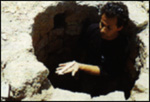
| |

 The silk industry revived by Fakhr ed-Din provided a livelihood for many people in Lebanon. In 1832
Lamartine described how the weavers worked - at the foot of the mulberry trees - on these beautiful silk
cloths of a thousand colours, whose threads they attach from tree to tree, weaving in the tree's shade.
The silk industry revived by Fakhr ed-Din provided a livelihood for many people in Lebanon. In 1832
Lamartine described how the weavers worked - at the foot of the mulberry trees - on these beautiful silk
cloths of a thousand colours, whose threads they attach from tree to tree, weaving in the tree's shade.
Beirut was surrounded by mulberry plantations. In 1841 the entire area north of the Islamic shrine is reported to have been green with trees. Plant samples from the excavation have been collected for analysis. Silkworms feed on mulberry leaves and weave cocoons. The cocoons were steeped in boiling water and dried in order to be able to reel the silk thread. The size of a silk manufactury was measured by the number of basins it operated. An Ottoman workshop excavated near the Islamic shrine had at least seven basins, a well and a cistern next to it.
| |
 al@mashriq 960118/960118 |

